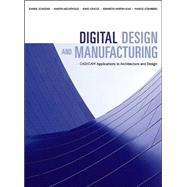
Note: Supplemental materials are not guaranteed with Rental or Used book purchases.
Purchase Benefits
What is included with this book?
MARTIN BECHTHOLD is an architect who has practiced in Hamburg, London, and Paris, and is Associate Professor of Architecture at the Harvard Design School.
KIMO GRIGGS is President of Kimo Griggs Architects and Kimo Inc. (a design and fabrication company), and an instructor on building technologies at the Harvard Design School.
KENNETH MARTIN KAO is a founding partner of Kao Design Group. He lectures on building construction and technology at the Harvard Design School and has also taught at MIT and ETH-Zurich.
MARCO STEINBERG is an architect with a Helsinki-based practice. He is Associate Professor of Architecture at the Harvard Design School and has taught architecture and industrial design at the Rhode Island School of Design.
| Preface | ix | ||||
| Acknowledgments | xi | ||||
|
1 | (26) | |||
|
3 | (14) | |||
|
3 | (2) | |||
|
5 | (7) | |||
|
12 | (5) | |||
|
17 | (10) | |||
|
17 | (1) | |||
|
17 | (5) | |||
|
22 | (2) | |||
|
24 | (3) | |||
|
27 | (102) | |||
|
29 | (18) | |||
|
29 | (5) | |||
|
34 | (1) | |||
|
35 | (1) | |||
|
36 | (2) | |||
|
38 | (3) | |||
|
41 | (2) | |||
|
43 | (4) | |||
|
47 | (32) | |||
|
47 | (3) | |||
|
50 | (1) | |||
|
50 | (3) | |||
|
53 | (10) | |||
|
63 | (16) | |||
|
79 | (14) | |||
|
79 | (5) | |||
|
84 | (4) | |||
|
88 | (5) | |||
|
93 | (24) | |||
|
93 | (13) | |||
|
106 | (2) | |||
|
108 | (9) | |||
|
117 | (12) | |||
|
117 | (1) | |||
|
117 | (5) | |||
|
122 | (1) | |||
|
123 | (2) | |||
|
125 | (4) | |||
|
129 | (48) | |||
|
131 | (22) | |||
|
131 | (1) | |||
|
131 | (6) | |||
|
137 | (1) | |||
|
138 | (3) | |||
|
141 | (12) | |||
|
153 | (24) | |||
|
153 | (2) | |||
|
155 | (1) | |||
|
155 | (5) | |||
|
160 | (1) | |||
|
161 | (8) | |||
|
169 | (8) | |||
|
177 | (58) | |||
|
179 | (14) | |||
|
179 | (1) | |||
|
179 | (3) | |||
|
182 | (3) | |||
|
185 | (4) | |||
|
189 | (4) | |||
|
193 | (26) | |||
|
193 | (8) | |||
|
201 | (7) | |||
|
208 | (4) | |||
|
212 | (3) | |||
|
215 | (4) | |||
|
219 | (16) | |||
|
219 | (1) | |||
|
220 | (6) | |||
|
226 | (4) | |||
|
230 | (5) | |||
|
235 | (90) | |||
|
237 | (18) | |||
|
237 | (1) | |||
|
237 | (2) | |||
|
239 | (5) | |||
|
244 | (1) | |||
|
245 | (5) | |||
|
250 | (5) | |||
|
255 | (42) | |||
|
255 | (1) | |||
|
256 | (12) | |||
|
268 | (16) | |||
|
284 | (13) | |||
|
297 | (16) | |||
|
297 | (1) | |||
|
297 | (3) | |||
|
300 | (1) | |||
|
301 | (6) | |||
|
307 | (6) | |||
|
313 | (12) | |||
|
313 | (1) | |||
|
314 | (11) | |||
|
325 | (28) | |||
|
327 | (8) | |||
|
327 | (1) | |||
|
327 | (2) | |||
|
329 | (2) | |||
|
331 | (4) | |||
|
335 | (10) | |||
|
335 | (1) | |||
|
335 | (3) | |||
|
338 | (1) | |||
|
339 | (6) | |||
|
345 | (8) | |||
|
345 | (1) | |||
|
346 | (7) | |||
| Notes | 353 | (4) | |||
| Index | 357 |
The New copy of this book will include any supplemental materials advertised. Please check the title of the book to determine if it should include any access cards, study guides, lab manuals, CDs, etc.
The Used, Rental and eBook copies of this book are not guaranteed to include any supplemental materials. Typically, only the book itself is included. This is true even if the title states it includes any access cards, study guides, lab manuals, CDs, etc.